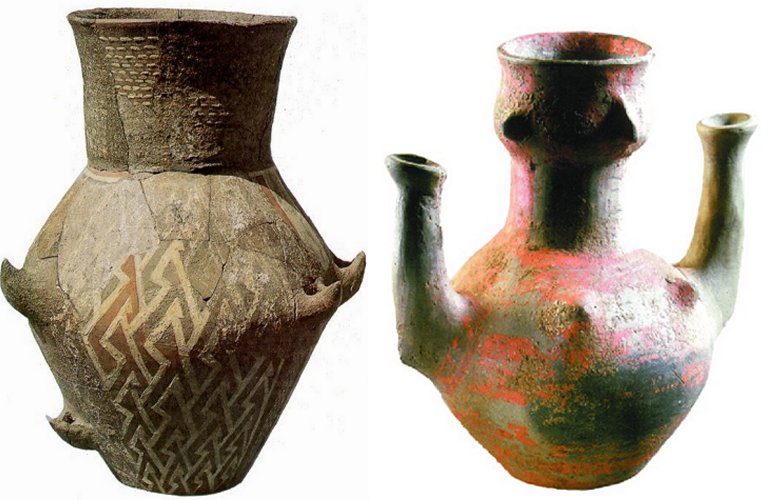Lengyel Culture Of Neolithic Europe Was Amazingly Sophisticated
A. Sutherland - AncientPages.com - The Lengyel culture that developed in southern Europe was initially linked to the site of Lengyel in Tolna county, in the southwestern part of Hungary.
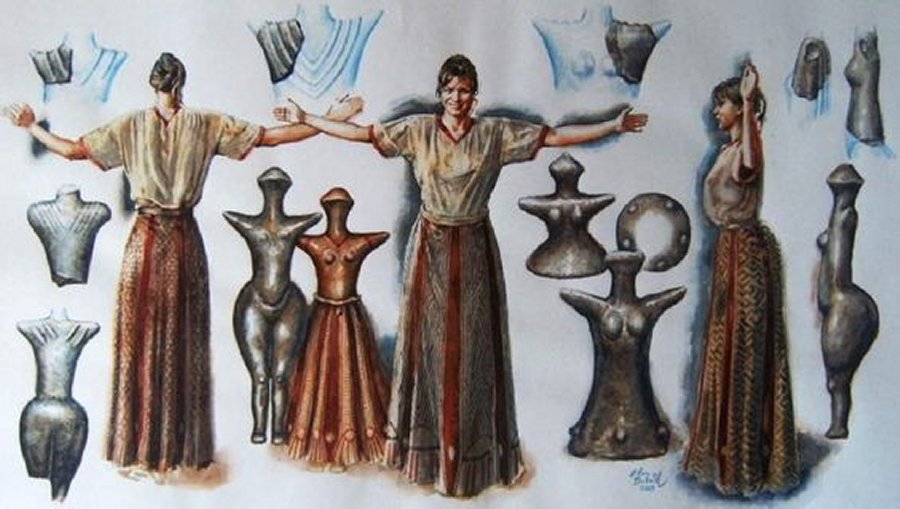 Lengyel culture traditions. source
Lengyel culture traditions. source
The Lengyel culture dates to ca. 5000 - 3400 BC, was the eastern successor to the Linear Ware culture. The settlements belonging to them were found in present-day Moravia (Czech Republic), Western Hungary, Western Slovakia, Southern Poland, and adjacent parts of Austria, Slovenia, and Croatia.
Small And Long Houses
People lived in open villages protected by ditches, and their houses were long rectangular or trapezoidal) multi-room buildings carved from clay, later also small rectangular or square pillar houses.
The society was engaged in agriculture, raising of animals like pigs, sheep and goats, hunting and fishing, cultivation of wheat, barley, and leguminous plants like lentils, peas.
Settlements of the Lengyel culture were large, widespread, and built on the river terrace, surrounded by V-shaped ditches and fences of buildings.
 Lengyel culture - A small dwelling model. Source
Lengyel culture - A small dwelling model. Source
For their protection, the people constructed defensive fortifications (often only on one side of the settlement).
'Roundels' And Ritual Activities
Early Lengyel culture was associated with circular earthworks of late Neolithic Europe known as (the 'roundels' or 'rondels'), where the ritual activities took place according to ancient traditions of these people.
The roundels (from 35 to 150 m in diameter) were considered their temples.
However, excavations carried out at many different sites of the Lengyel culture exposed the large enclosures that probably served only for ceremonial purposes because they lacked burials and pottery remains.
Not long ago, more than 130 roundels have been located in Europe, a third of them in Austria. The rest are in today's Hungary, Slovakia, Poland, the Czech Republic, and Germany. Currently, there are now ten known roundels, which are considered the oldest examples of monumental architecture in Europe.
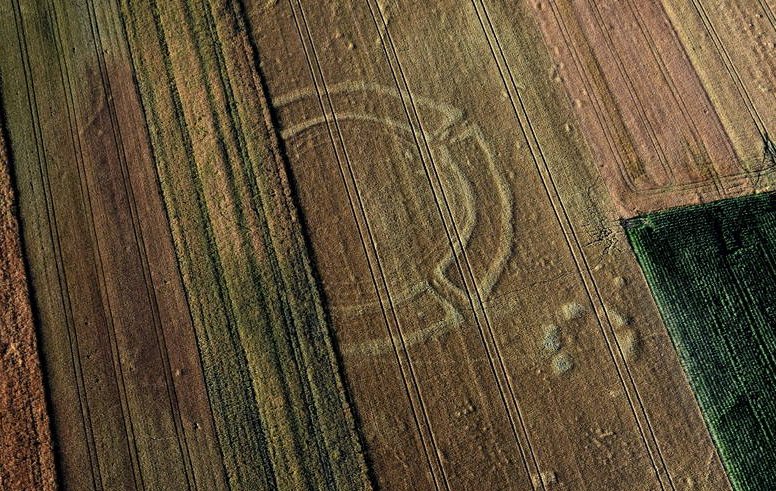 Aerial image of another Neolithic rondel enclosure located at Drzemlikowice, SW Poland. source
Aerial image of another Neolithic rondel enclosure located at Drzemlikowice, SW Poland. source
"A ditch that had four gates oriented in the cardinal directions formed the outer boundary of the monument; the enclosed area measured 145 by 125 meters. A roundel in the center of the ditch measured about 50 meters in diameter. It consisted of several poles set inside another ditch, and each of them opened to the four directions.
Excavations revealed an abundance of ritual evidence. They uncovered 314 early Lengyel-style figurines, inside the central roundel and the rest either outside of it or in the outer ditch. 1
The findings also included a sculpture of a goddess about forty centimeters tall, and ceramic vases painted in red, yellow, and white colors, and a human skull.
Another pit, on the other hand, contained a skeleton of a young woman buried in a contracted position. Her skull had been removed and buried under the wall of a grain pit. The Lengyel religious traditions are not precisely known; therefore, it is hard to say if the woman was buried in honor after natural death or ritually sacrificed during harvest rites.
Left: Lengyel culture pottery. source; Right: Anthropomorphic vessel from Svodín, dated to the Lengyel culture (after Nemejcová-Pavúková 1998, 65). source
The Lengyel pottery - found in a great variety of forms - includes bowls, small amphorae, zoomorphic and anthropomorphic vessels, pedestalled bowls, and ceramic figurines.
Early ceramics bear signs of painting with white, red, and yellow paints; otherwise, pottery was decorated with paintings or carved ornaments.
Body Parts Were Sometimes Separated
The deceased were buried in various ways. In the early period, the dead were not buried in the cemetery; this tradition appeared later. Sometimes their body parts (arms, legs, head) were separated and placed next to them, along with a boar or pig's lower jaw or fangs.
Triangular and trapezoidal burial mounds were found in southern Poland.
According to the Lengyel burial tradition, the group graves were located in large cemeteries or within settlements. Their equipment included vessels, stone tools, decorations, products made of bone, horn (horn axes), jewelry (bone beads, and beautiful geometrically decorated bone bracelets) and copper.
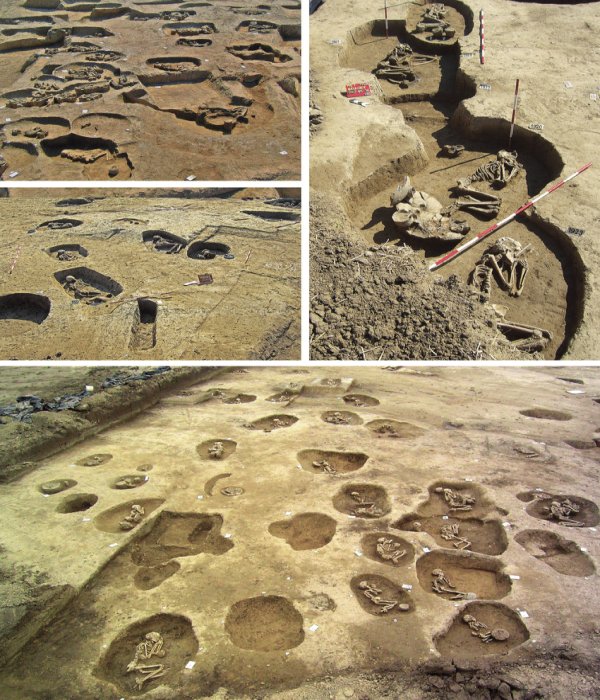 Lengyel culture grave groups. The Neolithic settlement of Alsónyék reached its greatest extent during the Late Neolithic Lengyel period. Nearly 9000 features, including postholes associated with 123 houses, pits and pit complexes, and ca. 2300 burials, could be assigned to it. The traces of Lengyel settlement and burials were found over the entire excavated area. Image credit: Alex Bayliss/ResearchGate
Lengyel culture grave groups. The Neolithic settlement of Alsónyék reached its greatest extent during the Late Neolithic Lengyel period. Nearly 9000 features, including postholes associated with 123 houses, pits and pit complexes, and ca. 2300 burials, could be assigned to it. The traces of Lengyel settlement and burials were found over the entire excavated area. Image credit: Alex Bayliss/ResearchGate
"Men were buried with tools and other artifacts suggesting trades and mining, like stone axes and hammer-axes made from antler and with nodules of flint and obsidian. The latter were mined in the nearby Carpathian Mountains.
Artifacts found with women also show their occupations. Some women's graves contained stone tools for hand-grinding and baking.
See also:
Lemko People – European Minority That Lost Their Homeland And Still Live In Exile
Who Were The Goths And Where Did They Come From?
"Tool kits for decorating pottery were found in several graves. But the types of artifacts found in male graves versus female graves are not subject to a strict division of labor." 1
In some cemeteries, archaeologists found quern stones, axes, chisels, or copper and shell jewelry in both male and female graves.
Women played an important role at home and in the religious traditions of the society. Many luxurious grave goods were unearthed in women's and young girl's tombs.
The Lengyel culture was not a complex society. Yet, they possessed an understanding of geometry, which can be seen in the culture's pottery remains, geometrically decorated bracelets, and the way they built their roundels and ditches as well.
Written by – A. Sutherland - AncientPages.com Senior Staff Writer
Copyright © AncientPages.com All rights reserved. This material may not be published, broadcast, rewritten or redistributed in whole or part without the express written permission of AncientPages.com
Expand for referencesJ. P. Mallory, Douglas Q. Adams, Encyclopedia of Indo-European Culture
- Marija Gimbutas. The Living Goddesses
More From Ancient Pages
-
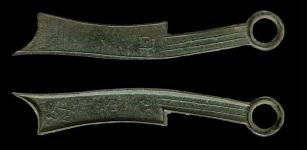 Scientists Decipher 2,300-Year-Old Chemistry Formulas Revealing Ancient Metallurgy Was More Complex Than Previosuly Thought
Ancient Technology | Aug 10, 2022
Scientists Decipher 2,300-Year-Old Chemistry Formulas Revealing Ancient Metallurgy Was More Complex Than Previosuly Thought
Ancient Technology | Aug 10, 2022 -
 Resourceful Pre-Hispanic Society In Bolivia Had Flourishing Agriculture Despite Harsh Environment Of The Andes
Archaeology | Dec 24, 2017
Resourceful Pre-Hispanic Society In Bolivia Had Flourishing Agriculture Despite Harsh Environment Of The Andes
Archaeology | Dec 24, 2017 -
 Ancient Symbol Hamsa: It’s Meaning And History Explained
Ancient Symbols | May 20, 2020
Ancient Symbol Hamsa: It’s Meaning And History Explained
Ancient Symbols | May 20, 2020 -
 Emperor Caligula’s Ancient Garden Found Under Piazza Pia In Rome, Italy
Archaeology | Jul 26, 2024
Emperor Caligula’s Ancient Garden Found Under Piazza Pia In Rome, Italy
Archaeology | Jul 26, 2024 -
 Strange Case Of The Vampire Doctor And The Dark Figure Remains Unexplained
Featured Stories | Oct 6, 2024
Strange Case Of The Vampire Doctor And The Dark Figure Remains Unexplained
Featured Stories | Oct 6, 2024 -
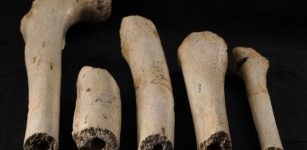 Ancient Human Remains A The Sima De Los Huesos Site Investigated
Archaeology | Mar 15, 2023
Ancient Human Remains A The Sima De Los Huesos Site Investigated
Archaeology | Mar 15, 2023 -
 Rudra – Mighty Hindu God Of Death, Destruction, Hunting Who Heals Mortal Diseases
Featured Stories | Aug 10, 2021
Rudra – Mighty Hindu God Of Death, Destruction, Hunting Who Heals Mortal Diseases
Featured Stories | Aug 10, 2021 -
 Your Neanderthal Genes May Prevent You From Metabolizing Drugs Efficiently
Archaeology | Jul 25, 2022
Your Neanderthal Genes May Prevent You From Metabolizing Drugs Efficiently
Archaeology | Jul 25, 2022 -
 Why Coyote Wanted People To Die For Their Own Good – A Caddo Nation Legend
Featured Stories | Jun 18, 2021
Why Coyote Wanted People To Die For Their Own Good – A Caddo Nation Legend
Featured Stories | Jun 18, 2021 -
 History Of Bread: Basic Food Of Man In Ancient And Contemporary Cultures Around The World
Ancient Traditions And Customs | Jun 18, 2023
History Of Bread: Basic Food Of Man In Ancient And Contemporary Cultures Around The World
Ancient Traditions And Customs | Jun 18, 2023 -
 Kindred Spirits: Why Did The Irish Build A Monument In Honor Of Native Americans?
Ancient History Facts | Oct 22, 2016
Kindred Spirits: Why Did The Irish Build A Monument In Honor Of Native Americans?
Ancient History Facts | Oct 22, 2016 -
 Untold Story Of The Glencoe Massacre In 1692 Revealed By Archaeologists In Scotland
Archaeology | Dec 18, 2024
Untold Story Of The Glencoe Massacre In 1692 Revealed By Archaeologists In Scotland
Archaeology | Dec 18, 2024 -
 Melusine: Charming Water Fairy In European Legend About Taboo And Broken Promise
Featured Stories | Jan 2, 2019
Melusine: Charming Water Fairy In European Legend About Taboo And Broken Promise
Featured Stories | Jan 2, 2019 -
 Controversial Stone Statues Of Niulang And Zhinyu And The Legend Of The Heavenly Queen And Milky Way
Artifacts | Sep 8, 2017
Controversial Stone Statues Of Niulang And Zhinyu And The Legend Of The Heavenly Queen And Milky Way
Artifacts | Sep 8, 2017 -
 Unusual 6,000-Year-Old Gold Objects Discovered In Hungarian Tombs – More Mysterious Conical Hats?
Archaeology | Mar 25, 2021
Unusual 6,000-Year-Old Gold Objects Discovered In Hungarian Tombs – More Mysterious Conical Hats?
Archaeology | Mar 25, 2021 -
 Cooper’s Ferry Site In Western Idaho Was Inhabited 16,000 Years Ago
Archaeology | Sep 3, 2019
Cooper’s Ferry Site In Western Idaho Was Inhabited 16,000 Years Ago
Archaeology | Sep 3, 2019 -
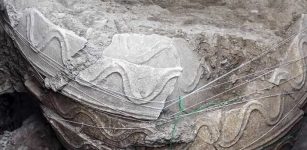 Bizarre Parthian Tomb Sheds Light On Ancient Life In Isfahan, Central Iran
Archaeology | Jun 25, 2020
Bizarre Parthian Tomb Sheds Light On Ancient Life In Isfahan, Central Iran
Archaeology | Jun 25, 2020 -
 Mysterious Green Light And Ancient Treasures – Cave Of The Gods And Its Secrets
Featured Stories | Jul 3, 2018
Mysterious Green Light And Ancient Treasures – Cave Of The Gods And Its Secrets
Featured Stories | Jul 3, 2018 -
 Homo Sapiens Survived In The Kalahari Desert More Than 20,000 Years Ago – Stone Age Discovery Shows
Archaeology | Aug 17, 2022
Homo Sapiens Survived In The Kalahari Desert More Than 20,000 Years Ago – Stone Age Discovery Shows
Archaeology | Aug 17, 2022 -
 Mysterious 2,000-Year-Old Disco Colgante – Unknown High-Tech Device, Representation Of A Spiral Galaxy Or Something Else?
Artifacts | Nov 20, 2020
Mysterious 2,000-Year-Old Disco Colgante – Unknown High-Tech Device, Representation Of A Spiral Galaxy Or Something Else?
Artifacts | Nov 20, 2020

